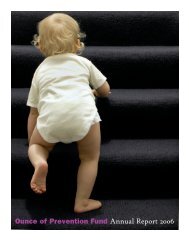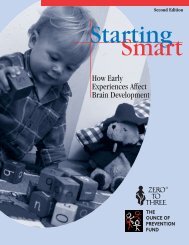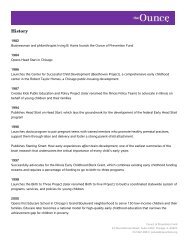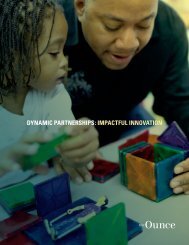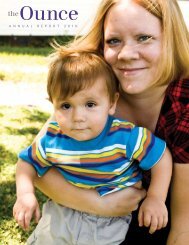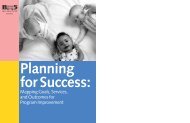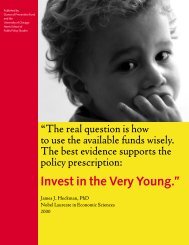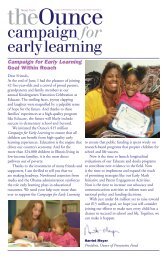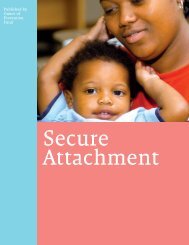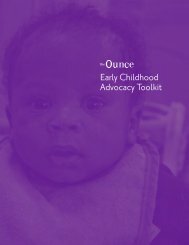Closing the Achievement Gap - Ounce of Prevention Fund
Closing the Achievement Gap - Ounce of Prevention Fund
Closing the Achievement Gap - Ounce of Prevention Fund
Create successful ePaper yourself
Turn your PDF publications into a flip-book with our unique Google optimized e-Paper software.
It’s Possible.<br />
<strong>Closing</strong> <strong>the</strong> <strong>Achievement</strong> <strong>Gap</strong><br />
in Academic Performance<br />
An <strong>Ounce</strong> <strong>of</strong> <strong>Prevention</strong> <strong>Fund</strong><br />
Publication
It’s possible.<br />
We can close <strong>the</strong> achievement gap in academic performance<br />
between low-income children and <strong>the</strong>ir more advantaged peers<br />
by recognizing first and foremost that this gap is actually a gap<br />
in school-readiness skills — one that is rooted in experiences<br />
that take place long before a child enters kindergarten.
Understand (<strong>the</strong> problem).<br />
The <strong>Achievement</strong> <strong>Gap</strong>: It’s Pervasive.<br />
Across <strong>the</strong> U.S., a persistent and widening gap in academic<br />
achievement exists between low-income students and <strong>the</strong>ir more<br />
advantaged peers. By age four, an 18-month gap is apparent between<br />
an impoverished child and his more affluent peers; that gap is still<br />
present at age 10 and continues throughout high school. 1<br />
Low-income students consistently<br />
underperform on school coursework and<br />
on standardized tests, graduate high<br />
school at lower rates, and are less likely<br />
to attend college. As a result, <strong>the</strong>y are<br />
ill-prepared to meet <strong>the</strong> challenges <strong>of</strong><br />
today’s workforce, which <strong>of</strong>ten forces<br />
<strong>the</strong>m into low-skilled, low-paying jobs that<br />
will not help <strong>the</strong>m escape poverty.<br />
The achievement gap is clearly one <strong>of</strong><br />
<strong>the</strong> most serious threats confronting<br />
<strong>the</strong> health <strong>of</strong> our nation’s economic and<br />
social systems today. Developing and<br />
implementing effective programs and<br />
policies that narrow <strong>the</strong> gap are essential<br />
to building our country’s human capital<br />
and maintaining our competitiveness in a<br />
global economy.<br />
It’s Evident Before Kindergarten.<br />
Our nation’s public schools simply do<br />
not have <strong>the</strong> capacity or resources to<br />
remediate skills for <strong>the</strong> overwhelming<br />
number <strong>of</strong> children who are not<br />
academically or socially ready for school.<br />
Children who enter our K-12 public<br />
school systems unprepared are <strong>of</strong>ten<br />
unable to take full advantage <strong>of</strong> what<br />
<strong>the</strong> classroom has to <strong>of</strong>fer. These are<br />
<strong>the</strong> children who struggle to keep up<br />
academically in class, who are frequently<br />
placed in special-education programs,<br />
labeled as having behavioral problems,<br />
or held back one or more grade levels.<br />
Once established, gaps in schoolreadiness<br />
skills are difficult — and<br />
more costly — to remedy, leading to<br />
pronounced gaps in achievement. A<br />
study <strong>of</strong> a 1998-99 kindergarten cohort<br />
found that <strong>the</strong> gaps in achievement<br />
for children who entered kindergarten<br />
with lower mean achievement scores in<br />
reading and math were wider still by <strong>the</strong><br />
end <strong>of</strong> third grade. 2<br />
<strong>Ounce</strong> <strong>of</strong> <strong>Prevention</strong> <strong>Fund</strong> 1
The challenge is even greater for <strong>the</strong><br />
growing number <strong>of</strong> young children from<br />
non-English-speaking homes. A Chicago<br />
study <strong>of</strong> low-income children entering<br />
public kindergarten found that twice as<br />
many children from non-English-speaking<br />
homes scored in <strong>the</strong> lowest ranges on<br />
standardized tests measuring language<br />
skills. 3<br />
It’s Not Just Hard Skills.<br />
Young children need both cognitive and<br />
social skills to enter school with <strong>the</strong><br />
confidence, motivation, persistence<br />
and curiosity that will prepare <strong>the</strong>m<br />
to be successful learners. In effect,<br />
<strong>the</strong> achievement gap reflects a gap in<br />
school-readiness skills.<br />
Young children need both cognitive and social skills to enter school<br />
with <strong>the</strong> confidence, motivation, persistence and curiosity that will<br />
prepare <strong>the</strong>m to be successful learners.<br />
2 www.ounce<strong>of</strong>prevention.org
By <strong>the</strong> Numbers<br />
Illinois has one <strong>of</strong> <strong>the</strong> most pronounced achievement gaps in<br />
<strong>the</strong> nation—only seven o<strong>the</strong>r states have a greater disparity in<br />
educational attainment. 4<br />
¼-½<br />
One-quarter to one-half <strong>of</strong><br />
18-to-24-year-olds in rural and<br />
inner-city areas <strong>of</strong> <strong>the</strong> state<br />
have no high school diploma,<br />
compared to 2% to 11% <strong>of</strong><br />
those living in many Chicago<br />
suburbs and pockets <strong>of</strong><br />
downstate Illinois. 4<br />
40 %<br />
In Illinois, only 40% <strong>of</strong> Black<br />
males graduated high school<br />
with <strong>the</strong>ir 2005–06 class,<br />
compared to 82% <strong>of</strong> <strong>the</strong>ir<br />
White classmates. 5<br />
less than<br />
In 2007, less than one-third<br />
<strong>of</strong> 11th grade Hispanic Chicago<br />
Public Schools students<br />
passed <strong>the</strong> state reading test,<br />
while more than twice that<br />
percentage <strong>of</strong> White students<br />
passed <strong>the</strong> test. 6<br />
two-thirds<br />
An estimated two-thirds <strong>of</strong><br />
public school fourth graders<br />
cannot read at grade level.<br />
More than 80% <strong>of</strong> Black and<br />
Latino fourth graders cannot<br />
read at grade level, compared<br />
with 58% <strong>of</strong> <strong>the</strong>ir White peers. 7<br />
six<br />
The National Longitudinal<br />
Study <strong>of</strong> Youth shows<br />
that <strong>the</strong> gap in math skills<br />
between <strong>the</strong> lowest- and<br />
highest-income students<br />
is strikingly evident at<br />
age six. 8<br />
6 out<br />
<strong>of</strong> 10<br />
Six out <strong>of</strong> 10 fourth graders<br />
cannot do math at grade level.<br />
85% <strong>of</strong> Black fourth graders<br />
cannot do math at grade level,<br />
compared to 78% <strong>of</strong> Latino<br />
children and about half <strong>of</strong> White<br />
children. 7<br />
186,971<br />
In Illinois, 17% <strong>of</strong> children<br />
under age six live in families<br />
with incomes below <strong>the</strong><br />
federal poverty level. This<br />
puts 186,971 <strong>of</strong> <strong>the</strong> state’s<br />
youngest citizens at risk for<br />
entering school unprepared to<br />
learn to <strong>the</strong>ir fullest abilities. 9<br />
Twice as likely<br />
Children whose parents have not<br />
completed high school are<br />
twice as likely to be poor (48%)<br />
than are children <strong>of</strong> parents with<br />
a high school diploma (25%),<br />
while 3% <strong>of</strong> children with ei<strong>the</strong>r<br />
parent holding a college degree<br />
are poor. 10<br />
<strong>Ounce</strong> <strong>of</strong> <strong>Prevention</strong> <strong>Fund</strong> 3
The social and emotional skills (or so-called<br />
“s<strong>of</strong>t” skills) a child acquires before age<br />
five — <strong>the</strong> capacity to control her behavior<br />
or impulses, <strong>the</strong> ability to get along with<br />
o<strong>the</strong>r children or seek out and accept<br />
help — are just as important as academic<br />
skills in preparing her for school. Yet onethird<br />
<strong>of</strong> low-income children demonstrate<br />
significant behavioral problems at transition<br />
to kindergarten. 11<br />
Math skills at kindergarten entry — <strong>the</strong><br />
ability to recognize numbers, problem<br />
solve, use reasoning skills, and apply<br />
knowledge — are increasingly seen<br />
as an even better predictor <strong>of</strong> later<br />
academic success than early reading<br />
ability. Yet <strong>the</strong>re is a significant gap<br />
in achievement in math performance<br />
between low-income and higher-income<br />
children. 8<br />
Early language and literacy development<br />
is a key component <strong>of</strong> school preparation,<br />
and differences in vocabulary growth<br />
between children in low-income families<br />
and high-income families begin to appear<br />
as early as 18 months. By age three, <strong>the</strong><br />
average child in a low-income household<br />
knows fewer than half as many words as<br />
a child in a high-income household. 12<br />
It’s Exacerbated by Poverty.<br />
Science tells us that <strong>the</strong> early experiences<br />
and strong bonds babies develop with<br />
caring adults literally help build <strong>the</strong>ir<br />
brains. These earliest relationships shape<br />
brain development by helping young<br />
children learn to manage <strong>the</strong>ir behavior<br />
and emotions, which leads to <strong>the</strong> ability<br />
to focus <strong>the</strong>ir attention on <strong>the</strong> tasks <strong>of</strong><br />
learning.<br />
For low-income children, <strong>the</strong> complex<br />
process <strong>of</strong> healthy brain development<br />
is <strong>of</strong>ten compromised by <strong>the</strong> stress <strong>of</strong><br />
living in poverty. Parents struggling to<br />
cope with severe financial instability,<br />
unsafe neighborhoods, lack <strong>of</strong> medical<br />
care, hunger, and o<strong>the</strong>r stressors<br />
common to living in poverty may not<br />
be able to adequately respond to <strong>the</strong>ir<br />
babies’ needs, making it more difficult<br />
to forge <strong>the</strong> strong bonds required<br />
to help <strong>the</strong>ir babies thrive later in life.<br />
The overlay <strong>of</strong> poverty and this critical<br />
developmental phase means that our<br />
youngest children are most at risk during<br />
<strong>the</strong> period <strong>of</strong> <strong>the</strong> most substantial brain<br />
growth <strong>of</strong> <strong>the</strong>ir lives.<br />
Poor child care worsens <strong>the</strong> problem.<br />
Studies show that only 30% <strong>of</strong> infant/<br />
toddler care is adequate or better; a<br />
startling 10% is unacceptable. 13 Early<br />
Head Start, our nation’s best program<br />
for infants and toddlers living in poverty,<br />
reaches less than 3% <strong>of</strong> <strong>the</strong> eligible<br />
population. 14 Our most vulnerable<br />
children spend <strong>the</strong> years most critical<br />
to <strong>the</strong>ir brain development in <strong>the</strong> worst<br />
environments.<br />
4 www.ounce<strong>of</strong>prevention.org
Science tells us that <strong>the</strong> early experiences and strong bonds babies<br />
develop with caring adults literally help build <strong>the</strong>ir brains.<br />
<strong>Ounce</strong> <strong>of</strong> <strong>Prevention</strong> <strong>Fund</strong> 5
Demonstrate (solutions).<br />
The <strong>Ounce</strong> <strong>of</strong> <strong>Prevention</strong> <strong>Fund</strong><br />
Programs<br />
For more than two decades, <strong>the</strong> <strong>Ounce</strong><br />
<strong>of</strong> <strong>Prevention</strong> <strong>Fund</strong> has been a leader in<br />
developing, innovating and advancing<br />
high-quality, birth-to-five programs. Our<br />
programs are designed in response to<br />
what research shows is holding back<br />
children — particularly low-income<br />
children — from realizing <strong>the</strong>ir potential<br />
in school and beyond. By demonstrating<br />
how effective programs work, <strong>the</strong> <strong>Ounce</strong><br />
is in a unique position to improve <strong>the</strong><br />
lives <strong>of</strong> <strong>the</strong> children and families we<br />
serve directly in Illinois and to affect <strong>the</strong><br />
education outcomes <strong>of</strong> countless children<br />
at risk for school failure.<br />
The cornerstones <strong>of</strong> our solutions are<br />
voluntary home visiting and high-quality<br />
early learning programs.<br />
Voluntary Doula and Home Visiting<br />
In evidence-based home visiting programs,<br />
trained nurses and parent coaches provide<br />
child-development and parenting information<br />
to help teen parents create safe, stimulating<br />
home environments; model positive and<br />
language-rich relationships; and connect<br />
families to medical, dental, mental-health,<br />
and o<strong>the</strong>r supports.<br />
Home visiting programs increase children’s<br />
literacy and high school graduation rates,<br />
as well as how much parents read to<br />
<strong>the</strong>ir children. In addition, such programs<br />
increase positive birth outcomes for<br />
children, improve <strong>the</strong> likelihood that families<br />
have a medical home, and are credited with<br />
cutting child abuse in at-risk families by half.<br />
The <strong>Ounce</strong>’s groundbreaking doula<br />
program pairs pregnant teen mo<strong>the</strong>rs with<br />
a trained mentor from <strong>the</strong> community who<br />
guides <strong>the</strong> teen through late pregnancy,<br />
childbirth and into <strong>the</strong> early months <strong>of</strong> a<br />
baby’s life. The <strong>Ounce</strong> funds and provides<br />
technical assistance to home visiting<br />
programs, and is <strong>the</strong> leading provider <strong>of</strong><br />
pr<strong>of</strong>essional development and training for<br />
home visitors in <strong>the</strong> state.<br />
High-Quality Early Learning<br />
Quality center-based programs that are<br />
grounded in research and best practices<br />
help at-risk children succeed in school. In<br />
such programs, well-trained pr<strong>of</strong>essionals<br />
provide nurturing and continuous care<br />
for infants, toddlers, and preschoolers;<br />
build trusting relationships with parents;<br />
emphasize language and literacy<br />
development; support literacy activities in<br />
<strong>the</strong> home; and provide access to familysupport<br />
services.<br />
Since opening in 2000, <strong>the</strong> <strong>Ounce</strong>’s<br />
Educare Center in Chicago has set <strong>the</strong><br />
standard for high-quality early care and<br />
education, <strong>of</strong>fering a full-day, full-year<br />
program that fosters school readiness in<br />
vulnerable children. The Educare model has<br />
inspired program, philanthropic and policy<br />
leaders to partner to create o<strong>the</strong>r Educare<br />
centers nationwide. These centers make<br />
up <strong>the</strong> Bounce Learning Network <strong>of</strong><br />
Educare Centers.<br />
Recent evaluations <strong>of</strong> five Educare Centers<br />
in <strong>the</strong> Bounce Learning Network conducted<br />
by <strong>the</strong> Frank Porter Graham Child<br />
Development Institute at <strong>the</strong> University<br />
6 www.ounce<strong>of</strong>prevention.org
Advocate (for what works).<br />
<strong>of</strong> North Carolina show promising early<br />
returns. Kindergarten-bound Educare<br />
graduates — particularly those who enter<br />
<strong>the</strong> program at birth — approach national<br />
averages on measures <strong>of</strong> language and<br />
conceptual skills more than do most lowincome<br />
children. And children who began<br />
<strong>the</strong> Educare program between birth and<br />
two years old transition into kindergarten<br />
with vocabularies and school-readiness<br />
scores that meet or exceed national<br />
averages for all American children.<br />
Significantly, our Educare Follow-up Study,<br />
shows that <strong>the</strong> gains our students make<br />
persist into elementary school. 15 In addition<br />
to revealing <strong>the</strong> progress children are<br />
making during <strong>the</strong> critical early elementary<br />
school years, <strong>the</strong> study is giving us<br />
invaluable insight into how early childhood<br />
programs can better equip parents to help<br />
<strong>the</strong>ir children transition to kindergarten;<br />
cope with stress; identify, and enroll<br />
children in, high-quality elementary schools;<br />
and become coaches and advocates for<br />
<strong>the</strong>ir children’s education.<br />
Early Interventions<br />
Education policies and practices have<br />
not kept pace with <strong>the</strong> scientific evidence<br />
that shows a child begins learning at<br />
birth — not upon kindergarten entry.<br />
Investing in high-quality education<br />
programs achieves both social and<br />
economic gains. Longitudinal analyses<br />
find that <strong>the</strong>se programs positively affect<br />
children’s school achievement, reducing<br />
dropout rates and minimizing costs for<br />
remediation and special education.<br />
Early education also reduces public<br />
outlays for crime services, job training<br />
and joblessness. Leading economists<br />
confirm that early investments in human<br />
capital represent <strong>the</strong> most effective<br />
approach with <strong>the</strong> greatest return on<br />
public investment.<br />
Early interventions for disadvantaged<br />
children “raise <strong>the</strong> quality <strong>of</strong> <strong>the</strong><br />
workforce, enhance <strong>the</strong> productivity<br />
<strong>of</strong> schools and reduce crime, teenage<br />
pregnancy, and welfare dependency.<br />
They raise earnings and promote social<br />
attachment. Focusing solely on earnings<br />
gains, returns to dollars invested are as<br />
high as 15–17 percent (per year).” 16<br />
The <strong>Ounce</strong> has helped Illinois become a<br />
national model for what effective early<br />
education systems should look like. We<br />
are leading efforts to ensure that existing<br />
and new public resources are targeted<br />
to evidence-based models that promote<br />
early learning and improve parents’<br />
capacities to serve as <strong>the</strong>ir children’s<br />
first and most important teachers.<br />
Guided by science and ongoing evaluation,<br />
we partner with community-based agencies<br />
in Illinois and states across <strong>the</strong> country<br />
to streng<strong>the</strong>n <strong>the</strong>ir capacity to implement<br />
best practices. We are also mobilizing<br />
advocates from <strong>the</strong> private, public and<br />
academic sectors whose voices are<br />
essential to shaping public policies that<br />
effectively prepare vulnerable children for<br />
success in school and in life.<br />
Leading economists confirm that early investments in human capital<br />
represent <strong>the</strong> most effective approach with <strong>the</strong> greatest return on<br />
public investment.<br />
<strong>Ounce</strong> <strong>of</strong> <strong>Prevention</strong> <strong>Fund</strong> 7
Leverage (our impact).<br />
Private donations enable <strong>the</strong> <strong>Ounce</strong> to<br />
develop and evaluate new program<br />
and policy initiatives, and advocate<br />
for public dollars that bring successful<br />
programs to scale.<br />
Knowledge and Innovation<br />
By leveraging our knowledge and<br />
expertise, <strong>the</strong> <strong>Ounce</strong> is improving <strong>the</strong><br />
quality <strong>of</strong> early childhood programs and<br />
creating positive early experiences for<br />
hundreds <strong>of</strong> thousands <strong>of</strong> babies,<br />
toddlers, and preschoolers in Illinois<br />
and across <strong>the</strong> country.<br />
Developing Innovative Approaches<br />
As a platform for program and policy<br />
change, Educare is where we are<br />
developing and implementing important<br />
initiatives to help close <strong>the</strong> achievement<br />
gap. Our Infant and Toddler Language and<br />
Literacy Promotion Project is allowing us<br />
to formalize strategies for better engaging<br />
parents and children around language and<br />
literacy development. 17<br />
The Early Childhood Mental Health Project<br />
promotes age-appropriate social-emotional<br />
development and teachers’ capacity to<br />
address developmental concerns. 19<br />
Our new addition to Educare, <strong>the</strong> Family<br />
and Training Center, will house our “early<br />
parent education” innovations so that<br />
parents can help <strong>the</strong>ir children sustain early<br />
education gains. 20<br />
Evaluating Results<br />
Evaluating <strong>the</strong> impact <strong>of</strong> our programs is<br />
essential to help close <strong>the</strong> achievement<br />
gap. Important longitudinal studies such<br />
as <strong>the</strong> Educare Follow-Up Study and<br />
Home Visiting Study will inform programimprovement<br />
efforts and contribute to best<br />
15, 21<br />
practices throughout <strong>the</strong> field.<br />
Leveraging Our Impact<br />
The <strong>Ounce</strong> is a particularly effective<br />
advocate for young children and <strong>the</strong>ir<br />
families. By building a strong, non-partisan<br />
cadre <strong>of</strong> champions, we are strategically<br />
pursuing efforts to align early childhood<br />
services with <strong>the</strong> K-12 and higher<br />
education communities. Working toge<strong>the</strong>r,<br />
we can close <strong>the</strong> achievement gap<br />
and prepare all children to be more<br />
capable, productive participants in a 21st<br />
century economy.<br />
Through our Early Math Initiative, we are<br />
training teachers and supporting parents in<br />
helping children build <strong>the</strong> math and problemsolving<br />
skills needed for school success. 18<br />
By leveraging our knowledge and expertise, <strong>the</strong> <strong>Ounce</strong> is<br />
improving <strong>the</strong> quality <strong>of</strong> early childhood programs and<br />
creating positive early experiences for hundreds <strong>of</strong> thousands <strong>of</strong><br />
babies, toddlers, and preschoolers in Illinois and across <strong>the</strong> country.<br />
8 www.ounce<strong>of</strong>prevention.org
Sources and citations<br />
1. Promoting Effective Early Learning: What Every Policymaker<br />
and Educator Should Know. (2007). New York, NY: National<br />
Center for Children in Poverty.<br />
2. The Condition <strong>of</strong> Education 2004 (NCES 2004-077),<br />
Indicator 8. (2004). Washington, DC: U.S. Department <strong>of</strong><br />
Education, National Center for Education Statistics.<br />
3. The Chicago Program Evaluation Project: A Picture <strong>of</strong> Early<br />
Childhood Programs, Teachers, and Preschool-Age Children<br />
in Chicago. (2008). Princeton, NJ: Ma<strong>the</strong>matica Policy<br />
Research, Inc.<br />
4. Public Agenda for College and Career Success. (2008).<br />
Springfield, IL: Public Agenda Task Force and Illinois Board <strong>of</strong><br />
Higher Education.<br />
5. Given Half a Chance: The Schott 50 State Report on Public<br />
Education and Black Males, Executive Summary. (2008).<br />
Cambridge, MA: Schott Foundation for Public Education.<br />
6. “School Report Card 2007: <strong>Achievement</strong> by Race and<br />
Income.” (Oct. 31, 2007). Chicago, IL: Chicago<br />
Sun-Times.<br />
7. State <strong>of</strong> America’s Children 2008. (2008). Washington, DC:<br />
Children’s Defense <strong>Fund</strong>.<br />
8. Heckman, J. (2008). “The Economic Case for Investing in<br />
Disadvantaged Young Children.” Chicago, IL: University <strong>of</strong><br />
Chicago Press.<br />
9. Illinois Demographics <strong>of</strong> Young Poor Children. (2008). New<br />
York, NY: National Center for Children in Poverty.<br />
10. Annual Social and Economic Supplement, America’s Families<br />
and Living Arrangements, Table C8, Current Population<br />
Survey. (2008). Washington, DC: U.S. Department <strong>of</strong><br />
Commerce, Bureau <strong>of</strong> <strong>the</strong> Census.<br />
11. Rimm-Kaufman, S.E., Pianta, R.C., and Cox, M.J. (2000).<br />
“Teachers’ Judgments <strong>of</strong> Problems in <strong>the</strong> Transition to<br />
Kindergarten.” Early Childhood Research Quarterly, 15(2),<br />
147-166.<br />
12. Hart, B. and Risley, T.R. (1995). “Meaningful Differences<br />
in <strong>the</strong> Everyday Experiences <strong>of</strong> Young American Children.”<br />
Baltimore, MD: Brooks Publishing Co.<br />
13. NICHD Study <strong>of</strong> Child Care and Youth Development. (2006).<br />
Washington, DC: National Institute <strong>of</strong> Child Health and Human<br />
Development.<br />
14. The National Evaluation <strong>of</strong> Early Head Start: Early Head Start<br />
Works. (2005). Washington, DC: Zero to Three Policy Center.<br />
15. Generously funded by <strong>the</strong> Alvin H. Baum Family <strong>Fund</strong> and <strong>the</strong><br />
W. Clement & Jessie V. Stone Foundation.<br />
16. Heckman, J. (2006). “Investing in Disadvantaged Young<br />
Children Is an Economically Efficient Policy.” Chicago, IL:<br />
University <strong>of</strong> Chicago Press.<br />
17. Generously funded by <strong>the</strong> Louis R. Lurie Foundation, Polk<br />
Bros. Foundation, Chauncey and Marion Deering McCormick<br />
Foundation, Prince Charitable Trusts, and The Children’s<br />
Initiative – A Project <strong>of</strong> <strong>the</strong> J.B. and M.K. Pritzker Family<br />
Foundation.<br />
18. Generously funded in part by <strong>the</strong> Louis R. Lurie Foundation.<br />
19. Generously funded in part by The Blowitz-Ridgeway<br />
Foundation.<br />
20. Generously funded in part by <strong>the</strong> Arie and Ida Crown<br />
Memorial Foundation, <strong>the</strong> Buffett Early Childhood <strong>Fund</strong>, and<br />
<strong>the</strong> Oscar G. & Elsa S. Mayer Family Foundation.<br />
21. Planning grant generously sponsored by The Philanthropic<br />
Collaborative.
The <strong>Ounce</strong> <strong>of</strong> <strong>Prevention</strong> <strong>Fund</strong> gives children in poverty <strong>the</strong> best<br />
chance for success in school and in life by advocating for and providing<br />
<strong>the</strong> highest quality care and education from birth to age five.<br />
<strong>Ounce</strong> <strong>of</strong> <strong>Prevention</strong> <strong>Fund</strong><br />
33 West Monroe Street, Suite 2400<br />
Chicago, Illinois 60603<br />
312.922.3863<br />
www.ounce<strong>of</strong>prevention.org



